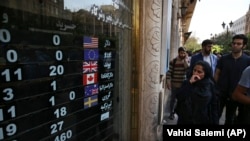The Iranian government's Statistical Center has announced the inflation rate for the year ending on February 20 as 42.3 percent.
Iran's Central Bank, whose statistics have been traditionally more realistic, has been officially barred from publishing reports on inflation and rising prices, and the Statistical Center is known for manipulating disparaging reports to please the government, according to Iranian media reports in recent months.
The year-on-year inflation rate for the Iranian month of Bahman (January 21- February 20) was 42.3 percent compared to the same period last year, the center reported on February 21.
Iran's currency has nosedived in the past year, driving all prices higher, as most products depend of imports, one way or another.
The report added that the highest rise in consumer prices has been observed in the market for "foodstuff, beverages and tobacco". The inflation rate for these goods during the past month has been 32.5 percent, with the annual inflation rate as high as 64.3 percent.
Even the hardliner pro-government Mashregh News website acknowledged that the price of meat has risen by 17% in one week in one month.
In spite of the hyperinflation reflected in these figure, the actual inflation appears to be even higher at least for foodstuff, which is the most important measure of well-being for ordinary people. Beef prices have risen 93 percent compared to 12 months ago, according to official figures, but people say on social media that beef prices have risen almost four-fold, to 1,200,000 rials a kilogram, or ten dollars ($4.5 per pound). This might be a reasonable price in an average country, but income of blue-collar workers in Iran is between $100-200 a month.
According to Iranian news reports, there have been long queues of buyers near stores and supermarkets in most cities, while others have complained in user-generated videos sent to foreign-based television stations that they have been unable to buy a kilo of meat for months. Still others, like the woman in the video below, complain about their reduced purchasing power as a result of high inflation.
The woman in this tweeted video shows two small plastic bags containing meat and oil and says this is what she could afford. The text of the tweet says, people are not supposed to buy meat, vegetables and many other foodstuff, but they can buy a burial spot.
In this tweet, the photo shows a long line in front of food stores, while the text sarcastically says, "People have lined up to show our price in pressures Zarif exerts for Palestine".
Meanwhile, some bakeries have closed because of flour shortage.
The sign posted at the entrance to a bakery says "We are closed because of lack of flour due to the ineptness of officials...
With such hardship people face, the political stability of the country can become perilous. Iran has been rocked by intermittent protests and workers' strikes in past 14 months.
Official figures show that the price of tobacco has risen by 136 percent, which is more than twice as much compared with last year.
Meanwhile the official figures indicate that fruit and vegetables prices and household furniture have had a 67 to 82 percent rise during the past year.
The report puts the rise in the price of other goods compared to same month last year at 33.5 percent.
According to the report, Iranian villages are more seriously hit by high inflation, as the annual inflation rate in rural areas has been 46.7% as opposed to the 41.5 percent in urban areas, meaning that prices have risen faster in villages compared to cities.
Inflation in Iran reached an uncontrollable level following the U.S. withdrawal from the nuclear deal with Iran in May 2018 and re-imposition of sanctions on Iran in August and November.
The International Monetary Fund (IMF) has evaluated Iran's inflation rate for 2018 at 29 percent and predicted a 35 percent inflation rate for 2019. But that calculation was based on a different methodology than the strictly year-on-year figures.
The IMF says the inflation rate in Iran has been always above 10 percent during the past 40 years since the 1979 Islamic revolution, however, the rise in inflation rate in Iran has been unusually high in some of those years.
Last year, well-known economist Professor Steve Hanke predicted hyperinflation for Iran in 2019, while observing that the rate of inflation in mid 2018 surpassed 150 percent for period of time.
Hyperinflation in Iran is caused by a combination of the impact of hard hitting sanctions, systematic financial corruption, mismanagement, spending on military operations in Syria, Iraq, Lebanon, Yemen and elsewhere in the Middle East and North Africa, spending hefty sums on developing ballistic missiles and the nuclear establishments, as well as allocating billions of dollars to religious institutions to buy the loyalty of hardliner clerics.



